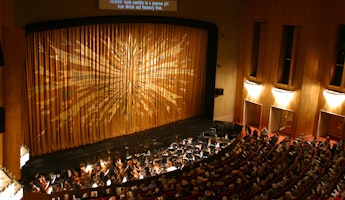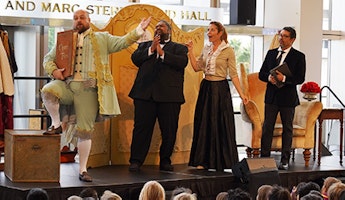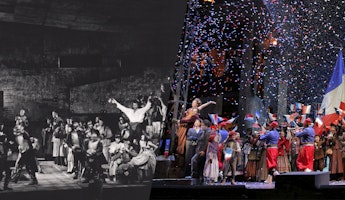Blog
August 20, 2024
Reorienting "Madame Butterfly" from the "White Gaze" to Inclusive Opera
by Ashlyn Aiko Nelson, Ph.D.
About 20 years ago, I attended a production of Madame Butterfly at San Francisco Opera. Even now, I recall the state of cognitive dissonance I experienced as an audience member. I wanted to immerse myself in the voices of the opera singers and in the visually stunning set design but couldn’t shake my discomfort with the representation of the Japanese characters. As one of the only Asian audience members, I felt self-conscious and complicit with the racial stereotyping I witnessed.
Madame Butterfly is the sixth most performed opera in the world and has occupied a position of privilege within the operatic canon for more than a century. At the same time, the opera portrays Asian women as submissive caricatures, and opera companies often employ historically inaccurate depictions of Japanese culture and dress in Madame Butterfly productions.
The continued prominence and commercial success of Madame Butterfly underscores the pervasiveness of the “white gaze” throughout the opera industry. Novelist Toni Morrison popularized the term “white gaze,” which refers to the assumption that the default perspective of an audience is white, and the idea that others’ lives have “no meaning and no depth” beyond the perceptions of white observers. Puccini’s Madame Butterfly exemplifies the white gaze: the opera is a Western fantasy of Asian exoticism, composed for white audiences.
The performing arts currently face a collective reckoning with the “white gaze.” Many opera companies globally are now reimagining opera for a more diverse audience, both because of a growing acknowledgment of how the canonical repertoire perpetuates racial stereotyping and typecasting, and because adapting to an increasingly diverse world is imperative for sustaining the commercial viability of the opera industry.
Yet reimagining opera in this context is no small feat, especially because opera audiences and the opera industry remain overwhelmingly white, and thus perpetuate the “white gaze.” Data from the Survey of Public Participation in the Arts by the National Endowment for the Arts indicates that more than three-quarters of opera audiences are white. OPERA America recently reported that more than 80% of opera company boards and staff are white, and a recent opera industry report from Indiana University found that the vast majority of voice faculty and students at universities and conservatories are white. Further, racially and ethnically diverse opera singers face fewer opportunities in the absence of race-based typecasting into traditional repertoire roles. For example, Nina Yoshida Nelsen and Nicholas Phan of the Asian Opera Alliance recently released data showing that the representation of Asian opera singers is 26% lower among opera companies if they do not include casting data from Madame Butterfly productions.
Decentering the “white gaze” to reach more diverse audiences requires a concerted effort to make the opera industry more inclusive at all levels. Voice programs within universities and conservatories are largely responsible for the demographic composition of the opera pipeline, so these programs must make an effort to recruit, admit and retain diverse individuals. Part of this strategy requires diversifying staff and faculty within these institutions. Also essential is recruiting, hiring and retaining racially and ethnically diverse individuals into opera companies, and especially into leadership positions as artistic directors and board members. Research shows that organizations with greater racial diversity—especially among individuals who hold decision-making authority—are more likely to demonstrate outcomes that benefit historically underrepresented groups. Greater diversity in opera company leadership can facilitate innovation in how companies recruit, cast and compensate diverse talent, as well as how they select and produce repertoire. Collectively, these efforts have the potential to shift the demographic composition of opera audiences, as diverse individuals are increasingly able to identify with opera productions and casts.
Perhaps the most challenging aspect of making opera more inclusive lies in reimagining the opera itself. The solutions are not straightforward, as the case of Madame Butterfly illustrates. Eliminating the work from the canon entirely is impractical for opera companies today that rely on the stable ticket revenues that canonical productions generate, and also would reduce the representation of Asian singers in opera casts—at least until the canon includes operas with a greater diversity of roles and companies hire more equitably.
Fortunately, many opera companies today—LA Opera among them—have made important shifts in their approaches to presenting Madame Butterfly. Working in close collaboration with the Asian Opera Alliance throughout its preparation for this production, LA Opera has critically examined how to preserve the beauty of the opera while eliminating its harmful stereotypes and tropes, demonstrating how canonical operas can adapt to become more diverse, equitable and inclusive.
Ashlyn Aiko Nelson, Ph.D., is an economist and associate professor within the O’Neill School of Public and Environmental Affairs at Indiana University-Bloomington. She founded the O’Neill Office of Diversity, Equity and Inclusion. Last year, she led a collaboration between the O’Neill School and Asian Opera Alliance to produce a strategic plan to improve equity in the opera industry. She is a proud fourth-generation Japanese-American yonsei whose grandparents were incarcerated in the Gila River and Tule Lake concentration camps during WWII. Last season, she served as historical dramaturg for Boston Lyric Opera’s production of Madama Butterfly.
An earlier version of this article was published by Boston Lyric Opera.








/03-cosi/_dsc0996_pr.jpg?format=auto&fit=crop&w=345&h=200&auto=format)















